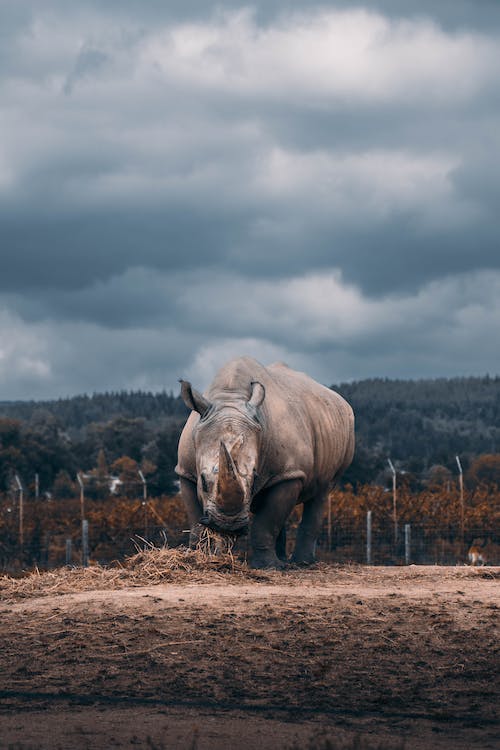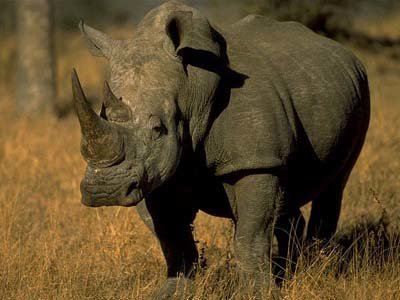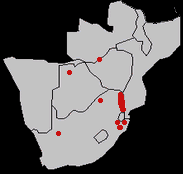LENGTH OF HEAD AND BODY (MALES LARGER): 3.6 - 4.2 metres
HEIGHT AT SHOULDER: 1.5 - 1.85 metres
MASS: 2 300 - 3 600 kilograms
LENGTH OF FRONT HORN (NORTHERN RACE): 95 - 200 centimetres
(SOUTHERN RACE): 95 - 101 centimetres
Despite their names, both the black and white rhinoceroses are grey. White rhinos are square-lipped, and are grazers; black rhinos have a hooked, prehensile upper lip and are browsers.
The White Rhinoceros is not white in colour; its name is derived from the Afrikaans / Dutch word "weit", meaning wide, and its manner of feeding has adapted to grazing short grass with a mouth similar to that of the business end of a lawnmower. This animal, with its territorial behaviour and rather slow rate of breeding, make it a poor colonist, and it is very slow to expand its range. White rhinos have a barrel-shaped body and short, thick-set limbs. The head is elongated, and the horns are continuously growing: one horn in front, and a shorter one behind. The skin is thick, grey, and prominantly folded on the front of the shoulders and on the upper part of the hind limbs.
White rhinos require areas of short grass, water for drinking and in which to wallow, adequate bush cover, and relatively flat terrain. These conditions are usually met in wooded grasslands. They do not have incisor teeth and instead use their hard lips to crop grass. They drink regularly and are dependant on its availability.
White rhino occur in small groups consisting of a single dominant or territorial bull, subordinate bulls, cows and their offspring. Territorial bulls occupy clearly defined territories which they defend against other bulls: these territories often have natural features which form their boundaries, and sometimes have narrow common zones. Territories are marked by urine spraying and defecating along the boundaries, and although territorial males rarely fight and tend to avoid one another, they do indulge in trials of strength, which may include horn clashing, to settle disputes and confirm social position. After a dispute, the defeated male may stay and feed in the defended area as long as he displays submissiveness, ceases to spray urine or scatter dung, and stays out of the proprietor's way.
The quality of food and the density of animals will establish the size of a feeding territory, especially in restricted areas such as a park or reserve. During full population density, a male's feeding territory is approximately 2 sq. km (¾ sq. mile). Males remain subsidiary in society from when they mature sexually, at the age of around seven, for about another three years until they are able to displace an existing bull and inherit his territory and females.
WILDLIFE PARKS AND RESERVES WHERE THIS SPECIES IS FOUND:
BOTSWANA
Okavango Delta ZIMBABWE
Gona-re-Zhou
Lake Kariba
Matobo Hills






